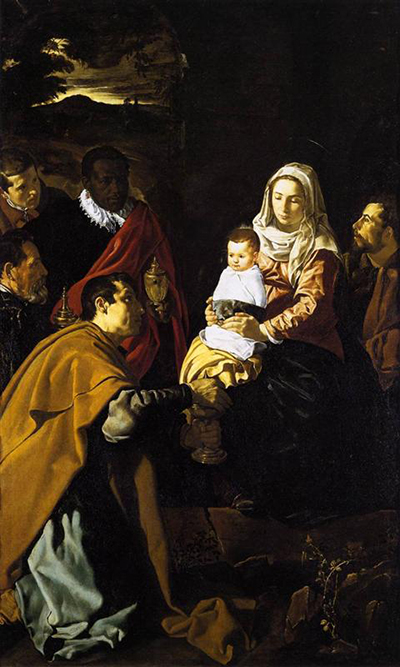Painted in 1619, The Adoration of the Magi is an earlier painting by Spanish artist Diego Velázquez and is typical of the religious themes he explored during this time. It is also the largest of his earlier works and may have been designed as an altarpiece.
The Magi featured in the work are more commonly known as the 'three kings' or 'wise men' who brought gifts to the infant Jesus in the Bible's Gospel of Matthew. Depicted presenting these gifts to the Christ child are Caspar, seen kneeling in front of Mary and the child, Balthazar, who is dressed in a red cape, and the bearded Melchoir who is crouched between the other two. Saint Joseph appears at Mary's left shoulder and there is an unidentified young man who peers over Balthazar's shoulder.
The tableau depicted here appears to be one of calm serenity which is further enhanced by the subtle lighting of the scene. A soft, warm light from the left of the picture is suggestive of candlelight.
The dusky landscape in the background depicts a time of twilight, of dusk, or a moment before dawn when all is calm and quiet. The light does not fall on the gifts of the Magi, which remain largely in shadow, and the rich colours of their garments, coupled with subtle expressions of adoration, bring our attention to their dignity as opposed to emphasising wealth or status.
With this, and the overall feeling of serenity, there comes a sense of reverence as the Magi pay their respects to the newborn king. Mary's eyes are cast downward in seemingly quiet contemplation, whereas the baby sits upright and alert showing a tranquil awareness. The brightest of the light falls upon Mary and Jesus as the main focus of the work and may also represent spiritual purity.
The sense of realism in the painting is typical of Baroque style and of Velázquez's work in particular. Indeed, it is thought that some of the figures bear a resemblance to family members.
The bearded king, for example, is said to resemble the artist's father-in-law, Francisco Pacheco, also a painter, with whom Velázquez had worked as an apprentice. Mary, meanwhile, has features similar to Pacheco's daughter, to whom Velázquez was married. The sense of realism is nonetheless transcended in other traditions of the Baroque style with a sense of depth and grandeur shown by light and shadow, the richness of the colours and the skillful depiction of expression, mood and atmosphere.
The Adoration of the Magi is currently held at the Museo del Prado in Madrid.




